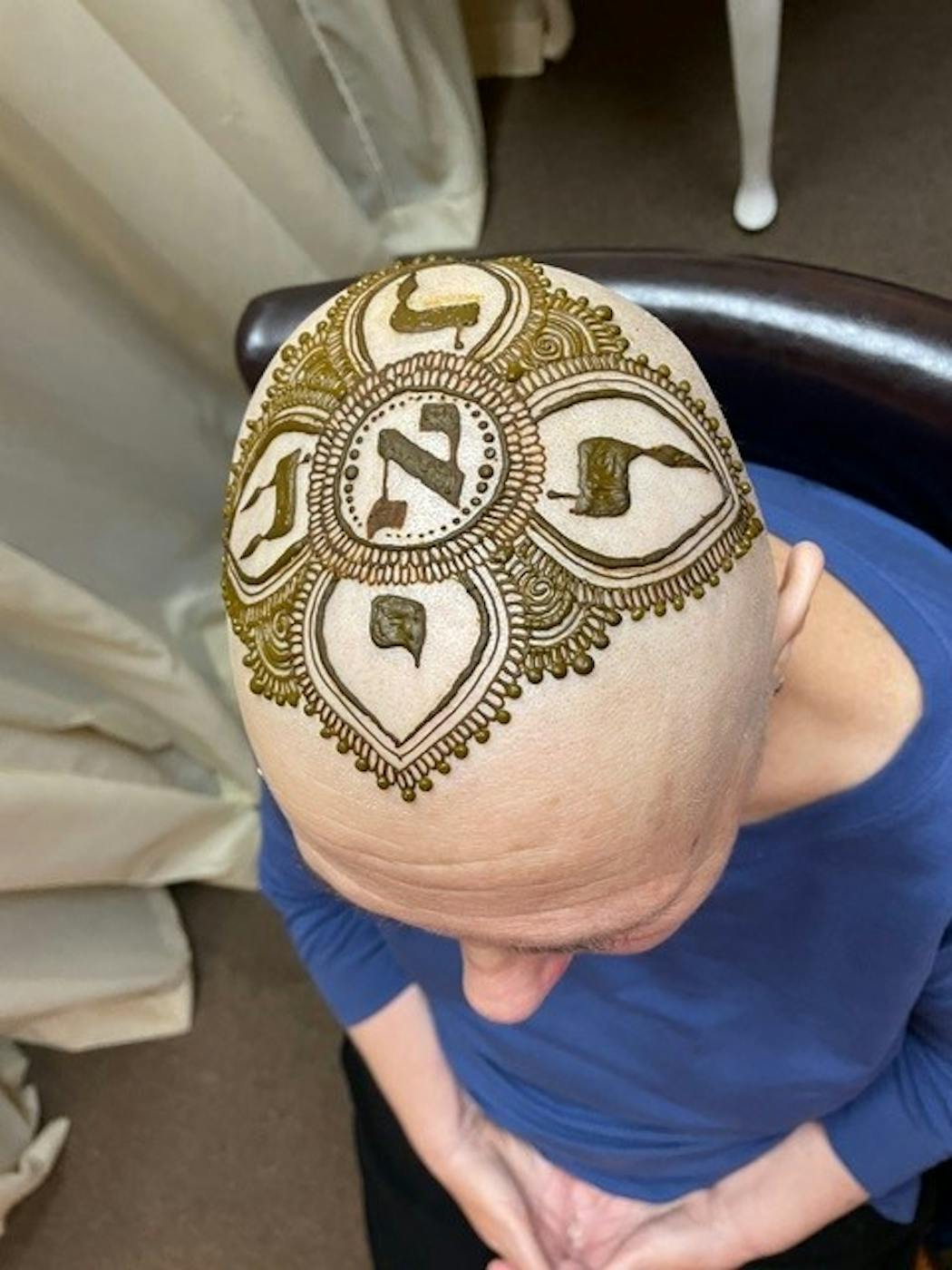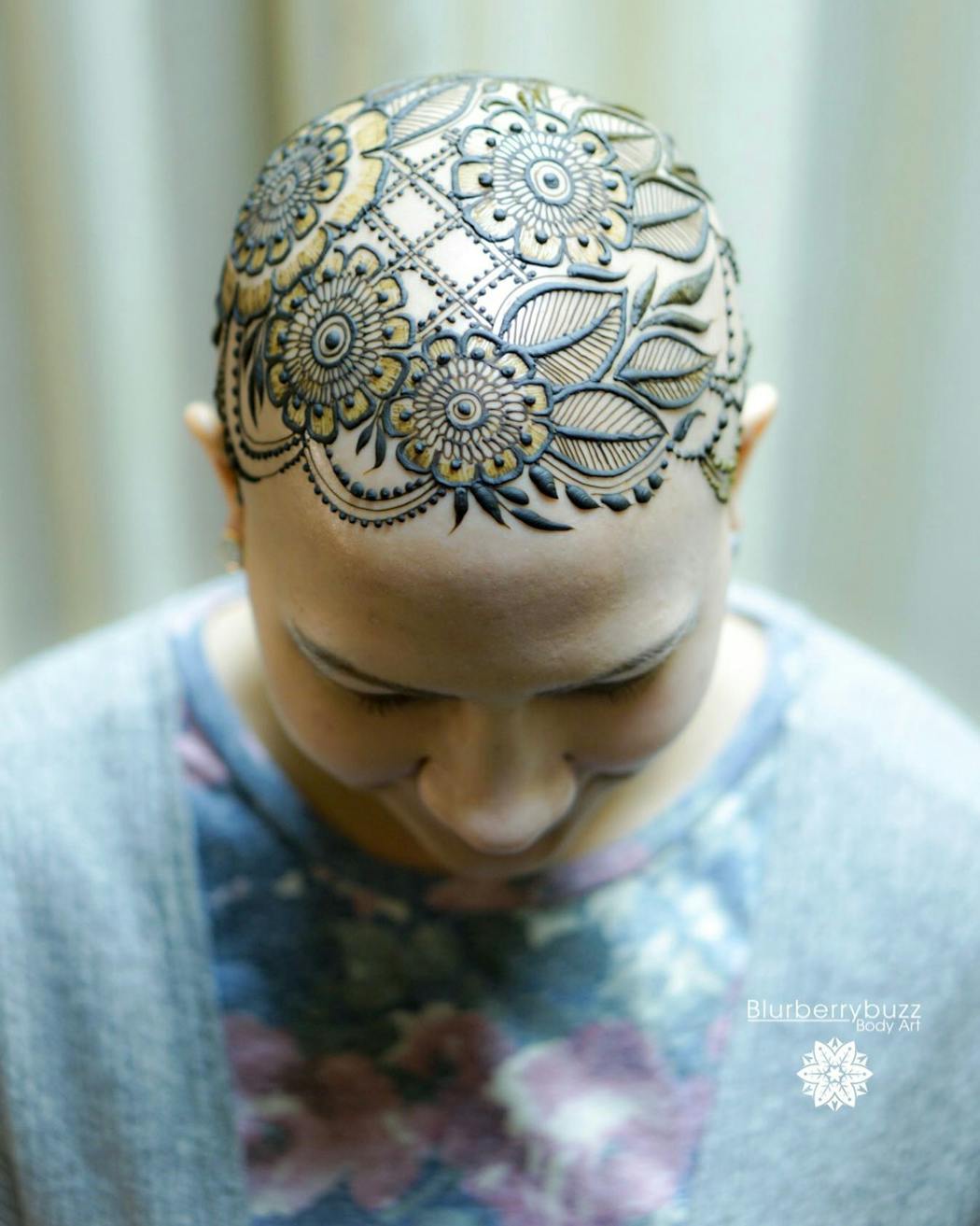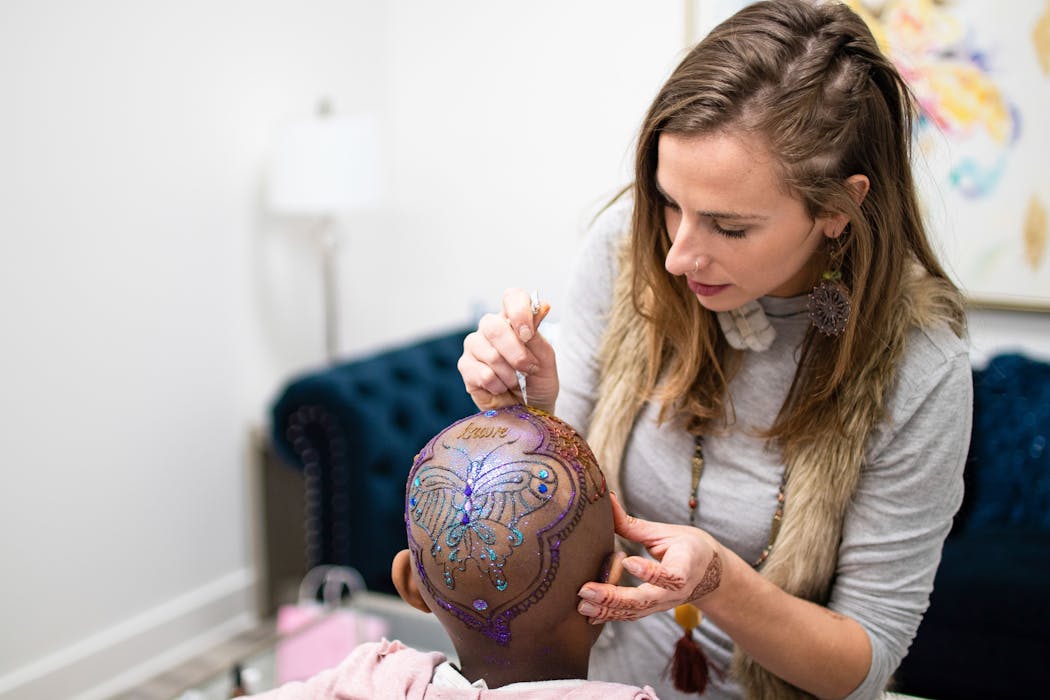Last fall, Lora DeVore dreamed that her body was being painted with Hebrew letters by beings in long, white robes.
The Golden Valley-based mental health professional was amid back-to-back health crises. After recovering from a severe case of COVID-19 last spring, DeVore found out she had breast cancer.
DeVore learned the meaning of the Hebrew symbols — unity, compassion and healing among them — and decided to have 22 letters painted all over her body using henna, the plant-based dye. Five of them, arranged in a blossom, were applied to her scalp, because she'd lost her hair during the month she spent hospitalized with coronavirus.
Adorning herself with the henna letters helped DeVore prepare for her upcoming mastectomy.
"I felt there was a sense of protection and blessing when I went into that surgery," she said. "There was something that was very soothing about having them on my body, and particularly on my head."
Henna has traditionally been used to stain skin, nails and hair in parts of North Africa, the Middle East and South Asia. While the decorative body art is most commonly applied to the hands and feet, some people who are bald — due to chemotherapy, alopecia or shaving their heads, among other reasons — choose to have henna applied to their scalp.
These so-called henna crowns change the way their wearers feel about themselves. And how others perceive them.
After DeVore lost her hair, she wore hats in public because she felt self-conscious, and avoided seeing her photos or reflections. But the henna crown changed her perspective.
"I just felt beautiful," she recalled. "It really did help me to shift the narrative of what was happening."
Bringing henna here
Shakuntala Maheshwari helped introduce Minnesotans to henna when she emigrated from India nearly 50 years ago. When the Orono artist and educator volunteered her face-painting skills at her children's school fairs, she also offered to apply mehndi (as it's known in Hindi and Urdu), which she'd learned as a child by watching the women in her family.
At first, Minnesotans were apprehensive about trying henna, Shakuntala said, so she would explain that the paste, made from ground leaves of the henna plant, would leave an orange hue that darkens to brown and then wears off in a week or two. (It's important to only use natural henna paste. Henna with chemical additives, known as black henna, can permanently damage the skin.)
Henna is traditionally used as a body decoration, like makeup, to make a person feel good about their appearance, Shakuntala said. While it's often associated with wedding ceremonies, where it can be used to impart a blessing, it's not specifically religious, she added. "Henna is done to relax your body, and for celebration," she said.
Shakuntala's daughter Reena joined her in applying henna at art and culture festivals. By the 1990s, their booth at St. Paul's annual Festival of Nations became one of the event's most popular, said Reena, who now offers henna services as part of her Minneapolis-based Kahani Events & Design. "Once Madonna started supporting henna, it became a lot more mainstream," she said.
Both mother and daughter said people of any ethnic group or gender may have henna applied without concerns of cultural appropriation. "There are so many positive things about every culture," Reena said. "And if we're able to share those, then we're spreading that joy and learning about each other and connecting."
Changing perceptions
While the Maheshwaris have each created a few henna crowns, Victoria Welch, the henna artist who painted DeVore's Hebrew letters, estimates that she's completed several hundred. Welch, who lives in Rosemount and owns Blurberry Buzz Body Art, started studying henna in the 1990s and has crowned some clients multiple times, as part of a regular beauty routine.
To Welch, the crowns help wearers change how they feel about themselves — and upend societal expectations about appearance. She noted how people without hair on their heads are often viewed as sick or weak. A henna crown can bring both beauty and intrigue.
"The looks change from 'Poor you' to 'Wow, what's that? Tell me about this head design. That's really cool,'" Welch said. "And it opens the door for real connection rather than just passing judgment based on appearance."
The crowns can help with self-acceptance, too. "When you've adorned your head and done something so intentional, you have the capacity to look in the mirror and love what you see rather than feel loss," Welch said.
One client with alopecia started showing her head in public for the first time in 20 years after being crowned, Welch said. Another client, who lost her hair due to chemo, told Welch: "I walked into your studio with cancer, and I walked out a badass."
A man with a shaved head once requested a henna crown before running a marathon, to sustain him through the physical challenge. "A henna crown empowers the person without hair to live a little more fully," Welch said.
Courage and connection
Henna artist Amanda Joy Gilbert of Grand Rapids, Mich., found painting crowns so powerful that she started the nonprofit Henna Crowns of Courage. The group's network of henna artists create free crowns for cancer patients, "turning this painful experience into something beautiful," Gilbert said.
Henna application involves involves touch, mindfulness, relaxation and connection — all helpful in reducing stress and anxiety.
Recipients will often request designs they find personally meaningful, but the artists wait until they're completely finished before recipients see their reflection. "When they look in the mirror, it's like they see themselves as the true essence of who they are," Gilbert said. "And they are goddesses and queens and Egyptian priestesses."
Shakuntala Maheshwari said she believes receiving henna can improve one's mood in the same way one might experience music or dancing. "All those things take you away from your disappointment or your anger," she said. "Art is the best healer."
Reflecting on her henna adornment, Lora DeVore described it as "very honoring" and said she'd "do it again in a heartbeat."
That may happen soon, as DeVore prepares for a significant event: the release of a memoir, about overcoming her traumatic childhood. This time, she's considering a phoenix design, to symbolize her personal transformation after having been though the fire.
"It can be a very sacred opportunity," DeVore said of receiving the ancient body art. "And it can really change your energy in relationship with whatever your circumstances are," she said.

Gophers football coach P.J. Fleck lists 'resort-style' Edina home for $3.9 million
Mexican film wins top prize at Moscow International Film Festival while major studios boycott Russia
Why you might have heard Paul Simon's 'The Sound of Silence' at Spanish Mass

Minneapolis native Poppy Harlow parts ways with CNN





